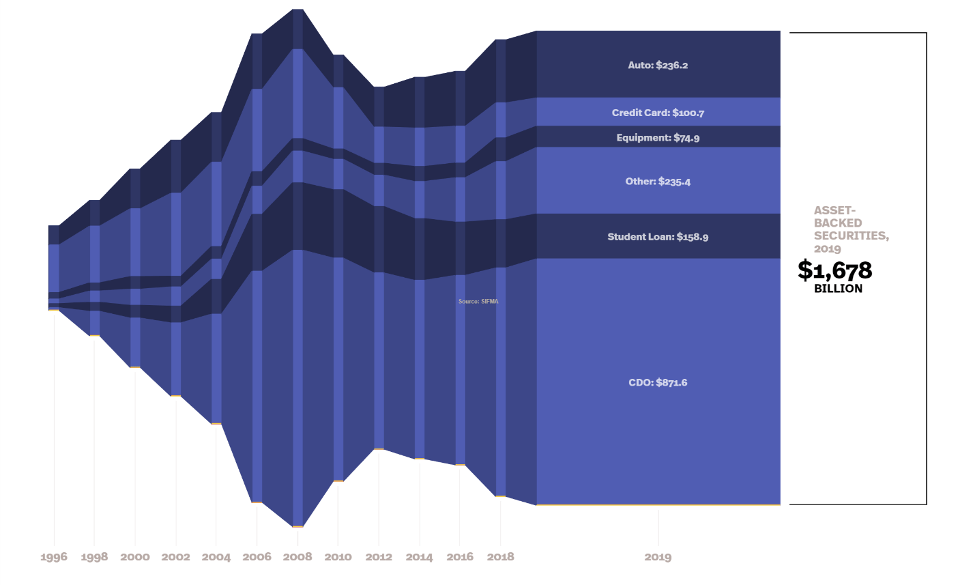Talking politics around the holidays is almost never a good idea—especially lately. However, I keep hearing about the idea that all, or a great majority of, student debt will be forgiven. Whatever your politics may be on this issue, for capital markets participants, there is potentially also a serious financial consideration.

As I mentioned in my previous post, SIFMA publishes tons of great info about outstanding debt, so I checked out the makeup of the asset backed securities, and was amazed to learn that there is almost $160 billion outstanding in bonds backed by student loans. Can the government really just wipe that out? It seems implausible, not impossible, but I'm hardly an expert in this sphere, so instead I decided to tap someone here—Tim McCrary, who has been working with us at Performance Trust since 2012 and for most of that time, has been engaged in the student loan space on a daily basis. He is an extremely popular speaker at our Advanced Courses and is regularly featured on our Level Playing Field calls. Given his expertise on the topic, you can imagine how thankful I was that he made himself available for this interview.

(Kurt) There has been a lot in the news recently about possible
student debt relief or cancellation. Before we get into what Congress or the
Biden administration is looking to do in the future, what has the government already
done this year to give student loan borrowers relief?
(Tim) To understand what Congress has already done, it's important
to make a distinction between the Federal Direct Lending Program (FDLP) and the
Federal Family Education Loan Program (FFELP). FDLP loans are owned by the government
and are originated directly with borrowers. These loans have been owned by the federal
government since they were originated and remain so today. FFELP loans, on the
other hand, were originated by third parties and are owned by private
investors. The FFELP started in the mid 1960s and ended in 2010, when it was
replaced by the FDLP in an attempt to save costs by cutting out the private
intermediaries. Because the FDLP has been in place since 2010, the majority of
outstanding student debt now falls under that program. To give some context,
there is roughly $1.6 trillion of outstanding student debt in America today,
and $1.3 trillion of that is in the FDLP loans. The remaining $300 billion is largely
in FFELP loans ($160 billion of which is securitized, as Kurt already
mentioned), with a small percentage being completely private student loans
(originated and owned by the private sector with no guarantee from the
government).
So with that background, let's look at what Congress has
already done. A portion of the CARES Act that was passed in March suspended
principal and interest payments on federally held student loans. While the
majority of student loan borrowers in America were eligible for this relief
(because the majority of outstanding student debt was originated under the FDLP
and as a result is owned by the government), loans in FFELP bond deals were not
eligible, as these loans are held privately by the trust and only reinsured by
the DOE, meaning they are not federally held student loans. This relief was later
extended to December, but consistent with the original law, it still did not
include the FFELP loans that are in bond deals. FFELP borrowers did get some
relief throughdisaster forbearance. This allowed
borrowers to suspend payments for around three months and waived interest
during that time. When the pandemic hit hard in the US, the situation was
classified as a national emergency and all borrowers were given the option of taking
disaster forbearance. That three-month period has since concluded and has not -
not yet at least - been renewed. It's worth noting that this disaster
forbearance did not suspend interest payments coming into FFELP bonds as the
DOE subsidizes loan holders with Special Allowance Payments (SAP), but it did slow
prepayment speeds for the near term.
So that's what the government has
done so far. What has been proposed for the future?
Many have put their support behind student debt
forgiveness over the last few years. Back in May of 2019, we did a breakout theme
on the LPF webinar in which we discussed debt forgiveness plans proposed by then-Democratic
Presidential candidates Bernie Sanders and Elizabeth Warren. These ideas were
relatively important parts of these candidates' policy platforms at the time,
but they lost momentum in the mainstream media when Joe Biden secured the
nomination. Over this past summer and fall, a number of proposals for further
economic stimulus included some form of student debt forgiveness, but none were
passed into law.
Now that the election has passed, and the country
prepares for a new administration in the White House, the jockeying for support
for a wide array of policy programs is going full force. Student debt relief is
no exception. Most notably, Elizabeth Warren and Chuck Schumer have called on
the incoming Biden administration to issue an executive order that would
forgive $50,000 of student debt per person, without any vote on the plan from Congress.
The Biden transition team has not shown support for this specific policy, and
there's question as to whether or not it's even legal, but earlier when a bill advanced
by House Democrats proposed forgiving $10,000 of student loan debt per borrower,
Mr. Biden showed support for the idea by saying it "should be done
immediately". Of course, that was in the middle of a campaign. Today, there are
numerous proposals being circulated concerning student debt forgiveness and
relief, and it's not useful here to go through all of them. The point is that
there is political momentum on the issue, especially among leaders of the
Democratic Party in both the legislative and executive branches.
If student debt were forgiven, how would it affect FFELP
bonds?
First, forgiving FFELP loans will likely be more
difficult for federal government to push through than would be forgiving the FDLP
loans that they own. We saw this difference in March, when it came to payment
relief. That said, politically, it's understandably difficult to tell certain borrowers
they get relief while others don't, as both groups took the government option
available to them at the time they needed money.
So let's assume debt forgiveness does become law and this
includes the FFELP loans underlying FFELP bonds. Previous proposals have designated
revenue sources with which to pay for this debt relief. For example, Elizabeth
Warren proposed a tax on individuals above a certain level of net worth, and
Bernie Sanders suggested a tax on all equity and fixed income trades. If there
is a dedicated revenue source associated with the debt relief, current holders would
presumably be paid back for any debt that is forgiven, especially if the
legality of the government's authority to outright forgive that debt is in
question. In the event that debt forgiveness passes and lenders (and hence, bondholders)
are repaid at par, overall, this would be a positive for the FFELP sector investors,
as the majority of these bonds trade at discount dollar prices (some are at
small premiums).
But what if debt is forgiven but not repaid to lenders at
par, and instead all the underlying loans in the securitized FFELP deals are
treated as defaults? While this could, and almost certainly would, lead to
legal battles between FFELP loan holders and investors in the subordinate
tranches of FFELP deals, most senior tranches would likely take no losses.
Let's run through why. Remember, FFELP loans are guaranteed
at a minimum rate of 97% of their outstanding principal balance, first by a third-party
guarantee agency and then this is reinsured by the Department of Education, this
latter being an explicit guarantee from a department of the federal government.
While this guarantee represents the lion's share of FFELP bonds' principal
protection, senior tranches also have credit enhancement. In most deals, senior
tranches enjoy the buffers of a combination of subordinate tranches,
overcollateralization, and reserves in the trust. These are all subordinate to the
senior tranches and take losses before them, which helps protect the senior
bonds from the risk of loss even if defaults rise significantly.
The last major consideration for FFELP Floater Bonds from
a principal protection standpoint is a concept called 'claim rejections'. In
unique circumstances, the Department of Education (DOE) may reject a guarantee
agency's reimbursement claim on a defaulted loan if the loan was originated or
serviced in a negligent or improper way. The occurrence of claim rejections is
very low, roughly 0.10-0.20% per period, for all submitted claims. Despite
being so low, it's worth mentioning because as I noted above, the 97% or more
guarantee on FFELP loans is the main bulwark of principal protection for the
bonds. Aside from net claim rejections, at least 97% of the balances for FFELP
loans are insured by the DOE, whose failure to honor their guarantee would be
analogous to guarantees not being honored on GNMA or SBA bonds. When we
consider these factors, even when running credit stress cases on FFELP Floaters,
assuming for the purpose meaningfully higher than ever observed default rates
and claim rejections, we have yet to see a senior FFELP floater take a loss
under these stresses.
To summarize
There is political momentum for broad-based student debt forgiveness from both Congress and President-Elect Biden, but whether this is enough to overcome broad-based popular resistance to the idea in many quarters remains to be seen. The legality of the government forgiving privately-owned FFELP loans is questionable, but even if it were permitted, and even if such forgiveness did not come with repayment to lenders from the federal government but rather resulted in the default of all FFELP loans, these senior tranches in FFELP bonds are unlikely to take losses. This is because the loans are guaranteed at 97% or more of their principal balance and senior bonds have credit enhancement greater than 3% in nearly every circumstance. Because these bonds are unlikely to take losses and largely trade at discount or small premium dollar prices, debt forgiveness would likely be an overall positive for investors in FFELP (assuming attractive alternative investments are available for the pay-off proceeds).
I want to once again thank Tim for his time.If you have more specific or more in-depth questions for Tim, he can be reached at tmccrary@performancetrust.com
Final, final thought: I'm not a huge chocolate fan and would probably never eat a peppermint stick…so why do I love peppermint bark so much?
Be sure to fill out the form below to subscribe to my weekly blog.


